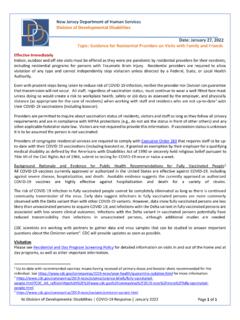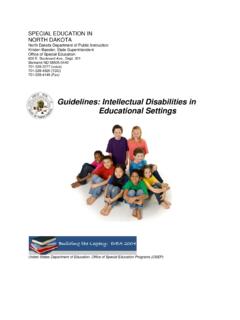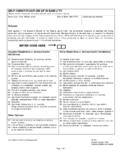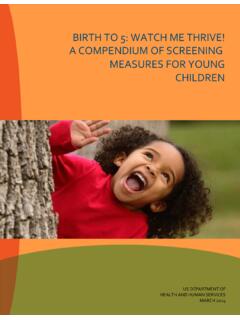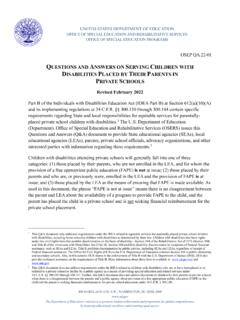Transcription of Disability Rights, Gender, and Development A Resource Tool ...
1 Ey Centers for Women Disability Rights, Gender, and Development A Resource Tool for Action This publication was developed by Rangita de Silva de Alwis, Director of International Human Rights Policy at the Wellesley Centers for Women, in collaboration with the Secretariat for the Convention on the Rights of Persons with disabilities of the Department of Economic and Social Affairs/United Nations and the United Nations Population Fund. Disability Rights, Gender, and Development A Resource Tool for Action Secretariat for the Convention on the Rights of Persons with disabilities of the Department of Economic and Social Affairs/United Nations United Nations Population Fund Wellesley Centers for Women The Wellesley Centers for Women Since 1974, the Wellesley Centers for Women has been a driving force, both behind the scenes and in the spotlight, promoting positive change for women and families. All work is grounded in the perspectives of women from diverse backgrounds.
2 Our research and action projects lead to creative solutions and innovative policy alternatives to a range of pressing social concerns. The Wellesley Centers for Women is the single organization formed in 1995 by combining the Center for Research on Women (founded 1974) and the Stone Center for Developmental Studies (founded 1981) at Wellesley College. WCW conducts scholarly research and develops sound training and evaluation programs that place women's experiences at the center of its work. WCW focuses on three major areas: The status of women and girls and the advancement of their human rights both in the United States and around the globe;. The education, care, and Development of children and youth; and The emotional well-being of families and individuals. Issues of diversity and equity are central across all the work as are the experiences and perspectives of women from a variety of backgrounds and cultures. For more information, please visit: Disability Rights, Gender, and Development A Resource Tool for Action Author: Rangita de Silva de Alwis, Director of International Human Rights Policy at the Wellesley Centers for Women, in collaboration with the Secretariat for the Convention on the Rights of Persons with disabilities of the Department of Economic and Social Affairs/.
3 United Nations and the United Nations Population Fund. Funding for this publication was provided by the UNFPA. Partial funding for some of the research was provided by a grant from the Open Society Institute. 2008 UN CRPD/DESA, UNFPA, Wellesley Centers for Women Suggested Citation: Secretariat for the Convention on the Rights of Persons with disabilities of the Department of Economic and Social Affairs; United Nations Population Fund; Wellesley Centers for Women, Disability Rights, Gender, and Development -- A Resource Tool for Action. (2008). Introduction As part of its global strategy to promote the Convention on the Rights of Persons with disabilities (CRPD) in Development activities and to mainstream Disability in all aspects of its work, the United Nations Population Fund (UNFPA); the Secretariat for the Convention on the Rights of Persons with disabilities (SCRPD/DESA) and the Wellesley Centers for Women (WCW) at Wellesley College have developed a unique compilation of Resource materials on innovative approaches to promote the human rights of persons with disabilities , especially women and children in inclusive people-centered Development .
4 Disability Rights, Gender, and Development : A Resource Tool for Action provides valuable insights on the theory and practice of human rights-based approaches to Development and contributes to this body of knowledge by designing innovative approaches to the implementation of the CPRD in gender and child sensitive Development activities. Building on existing experience in other human rights conventions, with a focus on the linkages among the CRPD, the Convention on the Elimination of All Forms of Discrimination Against Women (CEDAW), and the Convention on the Rights of the Child (CRC), the Resource manual is designed to provide an intersectional analysis of the different treaties and build capacity among all stake holders to use the normative frameworks of the different conventions within a holistic framework of interrelated rights. The first draft of these materials was developed for a pilot training program by the author in August 2008 for DESA staff members on the Human Rights Based Approaches to Development in the Context of Disability Rights.
5 The three overarching goals of the Resource manual are to: Increase the knowledge base to support and guide global efforts on inclusive Development in line with the Convention on the Rights of Persons with disabilities Strengthen the knowledge base to respond to the growing needs to support the implementation of the Convention through a human rights-based approach to Development . Incorporate the gender perspective in ANY Disability action: law/policy making, and programming to promote the rights of persons with disabilities . A hallmark of the new Convention on the Rights of Persons with disabilities (2006) is its distinctive focus on an integrated approach to human rights and Development and the promotion of the rights of persons with disabilities in all aspects of Development . CRPD. specifically include the reproductive rights of persons with disabilities as addressed in Article 23 and rights to sexual and reproductive health in Article 25.
6 This is consonant with the new target on universal access to reproductive health by 2015 of Millennium Introduction-1. Development Goal 5: improving maternal health, reproductive rights and sexual and reproductive health which cover a state of physical, mental and social wellbeing are not only critical to the advancement of Disability , gender and Development , but also a key interface among them. The work of the United Nations to pursue the goal of full participation of persons with disabilities in all aspects of society and Development is rooted in two main policy instruments: World Programme of Action concerning Disabled Persons (1982) and the Standard Rules on Equalization of Opportunities for Persons with disabilities (1993). which are both powerful tools to promote equality and empowerment of persons with disabilities . A series of international Development conferences and summits in the 1990s and their respective five-year reviews and follow-ups are of significant importance to persons with disabilities and their communities worldwide, particularly on issues such as poverty eradication, income generation, physical accessibility, advancement of women, adequate and accessible shelter as well as critical Development issues recently addressed by the international community in environmental or food crisis.
7 In view of the urgent need to promote the Disability rights- Development discourse at local, national regional and international levels and mainstream Disability in all aspects of implementation, monitoring and evaluation of the internationally agreed Development goals such as the MDGs, this Resource is envisaged to contribute to promoting the Disability perspective in Development and provide a basis for future activities and programmes. It is hoped that this Resource will contribute to practical action to effect positive changes on the ground- for persons with disabilities and their communities around the world. Secretariat for the Convention on the Rights of Persons with disabilities (SCRPD/DESA). United Nations Population Fund (UNFPA). Introduction-2. A Road Map to the Disability Rights, Gender, and Development : Resource Tool This Resource tool builds a normative framework to examine the intersections of Disability rights and gender in the human rights based approach to Development .
8 Through case studies, good practices and analyses the research tool makes recommendation and illustrates effective tools for the implementation of gender and Disability sensitive laws, policies and Development initiatives. The selected areas of discussion and analysis include: equality and non- discrimination; violence against women with disabilities ; traditional and customary practices that violate the rights of women and children with disabilities ; sexual and reproductive health and rights of women and youth with disabilities ; access to employment; and inclusive education. The tool is intended to educate, raise awareness and mobilize and galvanize groups around the twin goals of Disability and gender sensitivity in Development . Disability rights cannot be guaranteed in a context that does not affirm the equality of all women. Given that women with disabilities are some of the most marginalized segments of a community, a recognition of the multiple identities of women and children with disabilities and how that can construct their experiences of multiple forms of discrimination will help shape better Development programmes and rights-based laws and policies.
9 Using the Convention on the Rights of the Child (CRC) and the Convention on the Elimination of Discrimination against Women (CEDAW) and the Convention on the Rights of Persons with disabilities (CRPD) together enables a more comprehensive human rights-based approach that takes into account specific vulnerabilities based on age, gender, and Disability that result in violence and discrimination against women and children and women and children with disabilities . The three treaties also bring comparative strengths to the overall pursuit of all women's and children's rights. In combining the mandates of all three treaties, supported by the overall framework of the Universal Declaration of Human Rights, a powerful rights framework emerges to vindicate the rights of women and children within the private and public spheres. This Resource tool for the first time examines the connection between gender and Disability in Development and analyzes how gender, Disability and Development converge and intersect.
10 On the other hand, the CRPD complements and intersects with the CEDAW and the CRC and a gender perspective must be integrated into all aspects of Disability rights. In turn, Disability rights perspectives must inform the landscape of lawmaking for women and children in order to effectively transform the CRPD into concrete action in the domestic sphere. The Resource tool is divided into three modules and each module includes case studies and concrete action steps to guide human rights practice and the Development agenda on the ground. The Resource modules will be useful tools to UN country offices, government agencies, civil society organizations and academic institutions as background materials for education or training workshops for the Development of new Roadmap-1. legislative, policy or programmatic initiatives on behalf of women and children with disabilities . A preliminary draft of this Resource tool was used for a successful training program conducted by the author for the United Nations Secretariat for the Convention on the Rights of Persons with disabilities (SCRPD/DESA).










